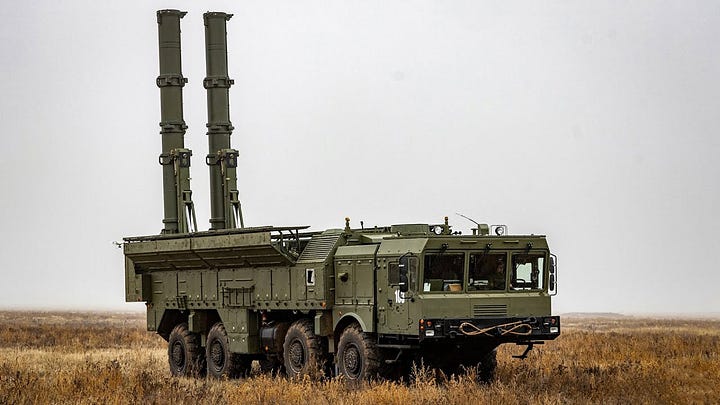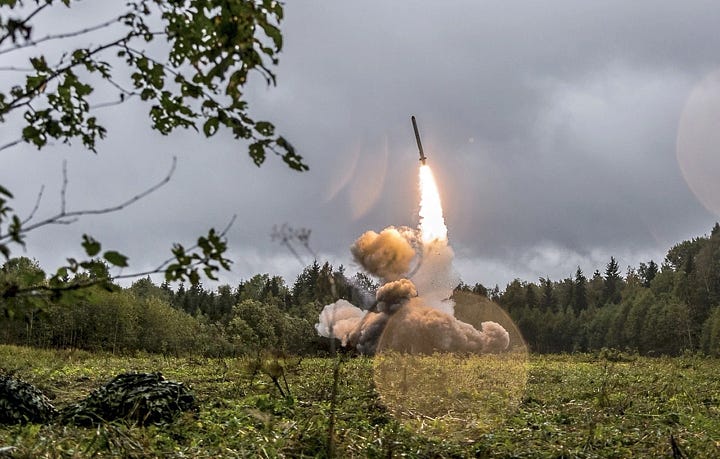Reported Russian Use Of "R-500" Ground-Launched Kalibr Cruise Missile Raises Questions About 9M729 Operational Status
🇷🇺 🇺🇦
Note: The following text was originally posted on my X/Twitter account.
The Russian 9M729 ground-launched land-attack cruise missile—the ground-launched version/derivative of the naval ship- and submarine-launched Kalibr subsonic land-attack cruise missile—has been the center has been at the subject of considerable controversy over the years. Its reported deployment by the Russian Army as a (conventionally-armed) cruise missile adjunct to the (primarily conventionally-armed) ballistic missiles ordinarily employed with the Iskander missile system, the combination of which results in the Iskander-K—as opposed to the Iskander-M—designation, is widely held to have contributed to the demise of the Intermediate-Range Nuclear Forces Treaty (INF Treaty) in 2018-2019. Its notoriety notwithstanding, the 9M729 does not appear to be regularly employed or employed in large numbers throughout the Russia-Ukraine War, even as the surface warships and submarines of the Russian Black Sea Fleet, which are otherwise the primary means of employing the Kalibr land-attack cruise missile design, have been attrited and suppressed by Ukraine's employment of anti-ship cruise missiles and uncrewed surface vehicles (USVs). Going by the Ukrainian Air Force's daily disclosures, Russia launched a total of just nine Iskander-K/ground-launched Kalibr land-attack cruise missiles over the course of August 2025.


On 9 August 2025, Russia is reported to have launched the two Iskander-K land-attack cruise missiles, one of which was reportedly intercepted. On 30 August 2025, Russia is reported to have launched a total of 37 land-attack cruise missiles of various types—a figure that aggregates air-launched, sea-launched, and ground-launched land-attack cruise missiles. At least one Iskander-K appears to have been intercepted on 30 August 2025. According to the Ukrainian Air Force's most recent monthly disclosure, Ukraine intercepted a total of nine Iskander-K land-attack cruise missiles over the course of August 2025, which is to say that Russia appears to have launched at least eight Iskander-K land-attack cruise missiles on 30 August 2025.
It is worth noting that the Ukrainian Air Force disclosures indicate that Russia launched at least thirty-three Iskander-K land-attack cruise missiles over the course of July 2025. The uncertainty stems from the fact that an uncertain number of Iskander-K were launched on 9 July alongside Kh-101 air-launched land-ttack cruise missiles in an otherwise large raid that reportedly involved a total of seven land-attack cruise missiles alongside a total of 728 propeller-driven strike drones and (seemingly) primarily unarmed decoy drones as well as six air-launched ballistic missiles. While the figure of at least thirty-three Iskander-K land-attack cruise missiles launched over the course of July 2025 may appear to be somewhat impressive if viewed in absolute terms, it is worth noting that these ground-launched land-attack cruise missiles were employed on just seven different days in that month and that the employment of either four or eight Iskander-K on a given day appears to be the norm. In itself, this indicates not only the limited availability of Iskander-K land-attack cruise missiles despite over three years of wartime industrial mobilization—which may or may not be reflective of Russian stockpiling of this munition—but also a limited number of launchers.
The most recent employment of the ground-launched Iskander-K land-attack cruise missile is reported to have taken place on 7 September 2025 in a large raid that involved a total of 810 propeller-driven armed strike drones and (seemingly) primarily unarmed propeller-driven decoy drones—the Ukrainian Air Force's daily disclosures do not disaggregate/differentiate decoy drones and strike drones. While Russia is reported to have launched a very large number of propeller-driven strike and decoy drones on 7 September 2025, it is reported to have launched just eight Iskander-K land-attack cruise missiles (as well as four Iskander-M and/or North Korean-built KN-23 ballistic missiles). Notably, the 7 September 2025 launch of eight Iskander-K ground-launched land-attack cruise missiles reportedly entailed the use of launcher vehicles located in Russia's Kursk province, which borders Ukraine and Ukrainian-controlled territory. The 30 August 2025 and 9 August 2025 employment of Iskander-K ground-launched land-attack cruise missiles, in contrast, reportedly entailed the use of launcher vehicles located in the Russian-occupied part of Ukraine's Zaporizhzhia province. It is notable that Russia appears to be launching such a long-range land-attack cruise missile from a forward location despite the excessive nominal maximum range of the Kalibr cruise missile design in the particular military-geographical context of the Russia-Ukraine War. It is unclear if Iskander-K launcher vehicles alternate between launch areas in Russia's Kursk province and the Russian-occupied part of Ukraine's Zaporizhzhia province.

